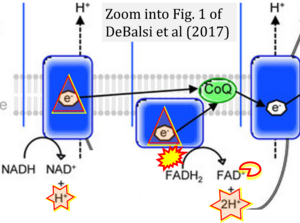DeBalsi 2017 Ageing Res Rev
| DeBalsi KL, Hoff KE, Copeland WC (2017) Role of the mitochondrial DNA replication machinery in mitochondrial DNA mutagenesis, aging and age-related diseases. Ageing Res Rev 33:89-104. https://doi.org/10.1016/j.arr.2016.04.006 |
DeBalsi KL, Hoff KE, Copeland WC (2017) Ageing Res Rev
Abstract: As regulators of bioenergetics in the cell and the primary source of endogenous reactive oxygen species (ROS), dysfunctional mitochondria have been implicated for decades in the process of aging and age-related diseases. Mitochondrial DNA (mtDNA) is replicated and repaired by nuclear-encoded mtDNA polymerase γ (Pol γ) and several other associated proteins, which compose the mtDNA replication machinery. Here, we review evidence that errors caused by this replication machinery and failure to repair these mtDNA errors results in mtDNA mutations. Clonal expansion of mtDNA mutations results in mitochondrial dysfunction, such as decreased electron transport chain (ETC) enzyme activity and impaired cellular respiration. We address the literature that mitochondrial dysfunction, in conjunction with altered mitochondrial dynamics, is a major driving force behind aging and age-related diseases. Additionally, interventions to improve mitochondrial function and attenuate the symptoms of aging are examined.
• Bioblast editor: Gnaiger E
Correction: FADH2 and Complex II
- FADH2 is shown as the substrate feeding electrons into Complex II (CII). This is wrong and requires correction - for details see Gnaiger (2024).
- Gnaiger E (2024) Complex II ambiguities ― FADH2 in the electron transfer system. J Biol Chem 300:105470. https://doi.org/10.1016/j.jbc.2023.105470 - »Bioblast link«
Hydrogen ion ambiguities in the electron transfer system
Communicated by Gnaiger E (2023-10-08) last update 2023-11-10
- Electron (e-) transfer linked to hydrogen ion (hydron; H+) transfer is a fundamental concept in the field of bioenergetics, critical for understanding redox-coupled energy transformations.
- However, the current literature contains inconsistencies regarding H+ formation on the negative side of bioenergetic membranes, such as the matrix side of the mitochondrial inner membrane, when NADH is oxidized during oxidative phosphorylation (OXPHOS). Ambiguities arise when examining the oxidation of NADH by respiratory Complex I or succinate by Complex II.
- Oxidation of NADH or succinate involves a two-electron transfer of 2{H++e-} to FMN or FAD, respectively. Figures indicating a single electron e- transferred from NADH or succinate lack accuracy.
- The oxidized NAD+ is distinguished from NAD indicating nicotinamide adenine dinucleotide independent of oxidation state.
- NADH + H+ → NAD+ +2{H++e-} is the oxidation half-reaction in this H+-linked electron transfer represented as 2{H++e-} (Gnaiger 2023). Putative H+ formation shown as NADH → NAD+ + H+ conflicts with chemiosmotic coupling stoichiometries between H+ translocation across the coupling membrane and electron transfer to oxygen. Ensuring clarity in this complex field is imperative to tackle the apparent ambiguity crisis and prevent confusion, particularly in light of the increasing number of interdisciplinary publications on bioenergetics concerning diagnostic and clinical applications of OXPHOS analysis.




